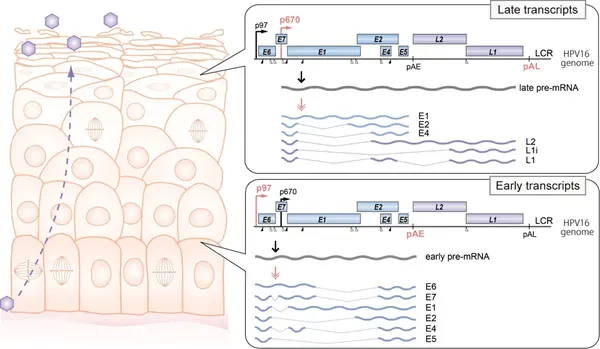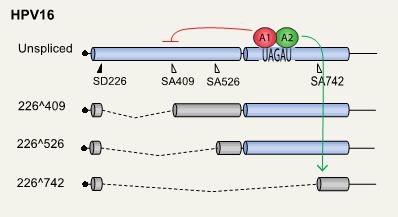Stefan Schwartz research group

Human papillomavirus type 16 life-cycle in mucosal epithelium, Naoko Kajitani©
Viral gene regulation
Human papillomavirus (HPV) infections cause more than 500.000 cases of cervical cancer each year in the world (>500 cases in Sweden), and over 250.000 deaths (135 deaths in Sweden). HPV16 is the most common cancer-associated HPV type. The majority of all HPV16 infections is cleared by the host but a fraction persists and may cause cancer. The full life-cycle of HPV16 requires cell proliferation at the early stage, and terminal cell differentiation at the late stage. Two HPV16 proteins termed E1 and E2 hijack the cellular DNA polymerase and use it for synthesis of new viral genomes. They are essential for HPV16 replication. The two HPV proteins E6 and E7 stimulate cell division and prevent apoptosis to ensure a continued supply of cellular DNA polymerase for HPV replication. As the levels of E2 reach a certain threshold, E2 shuts down the early promoter producing E6 and E7 mRNAs. As E6 and E7 levels decrease, the cells re-enter the differentiation program and differentiate terminally, a process that activate HPv16 late gene expression and the production of progeny virus. If HPV16-infected cells get stuck in the early stage of the HPV16 life-cycle with continuous E6 and E7 expression and a failure to shut down cell mitosis, these cells may acquire mutations that together with E6 and E7 drive the HPV16-infected cells toward cancer. E6 and E7 are the only HPV16 proteins needed to initiate the pathway to cancer and to uphold it. HPV16 makes extensive use of the cellular splicing machinery to generate different alternatively spliced and polyadenylated HPV16 mRNAs. For example, E1 and E2 are produced from two alternatively spliced RNAs generated in a mutually exclusive manner, and so are E6 and E7. The splicing balance is a delicate one and the smallest perturbation may greatly affect the HPV16 gene expression program. mRNA splicing is controlled by cis-acting RNA element and trans-acting factors. We are identifying the HPV16 RNA elements and the cellular RNA-binding proteins that interact with these RNA sequences and control HPV16 mRNA splicing. In addition, the HPV16 infection itself may alter expression of the cellular RNA-binding proteins for its own purpose. The regulation of E6 and E7 expression is of particular interest since they are viral oncogenes that are needed for transformation of the HPV16 infected cells to cancer cells, whereas E1 and E2 are of interest as essential HPV replication factors. Cellular factors that control HPV16 E1- and E2- or E6- and E7- mRNA splicing and expression, are potential targets for antiviral/anticancer therapy and/or as predictive biomarkers for disease or treatment outcome.
For a recent summary of papillomavirus gene regulation and RNA processing, including our own results, please have a look at the following review article.

Expression of human papillomavirus type 16 E6 and E7 oncogenes is controlled by the two cellular RNA-binding proteins hnRNP A1 and A2 (Kajitani, N., Schwartz, S. 2020. Role of viral ribonucleoproteins in Human Papillomavirus Type 16 gene expression. Viruses, 12 (10): 1110.).
